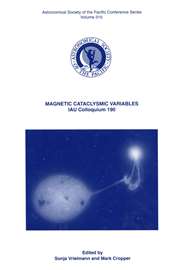No CrossRef data available.
Article contents
Reconstruction of Spectra obtained with PYTHEAS through Photometric Methods
Published online by Cambridge University Press: 12 April 2016
Extract
PYTHEAS is an imaging spectrophotometer giving high spectral and spatial resolutions in joining together several optical concepts (Le Coarer et al 1992, and Georgelin et al. in these Proceedings). It will be shown in this paper that, contrary to other spectrographs using somewhat complex methods of data reduction, the PYTHEAS imaging spectrometer requires simple photometric methods in order to reconstruct the spectra of astrophysical objects.
The CCD image of a continuous spectral energy distribution for a permanent gap between the layers of the Fabry-Perot consists in a series of channelled spectra: each elementary beam, spectrally filtered by the FP interferometer and sampled by a microlens in the frame, gives light to the whole surface of the grism which separates the various F-P orders by displaying them in a line on the detector. Each line or channelled spectrum consists of a series of Fabry pupils (spectral elements), each of them containing the luminous flux emitted on a certain wavelength by the object under investigation. After scanning the FP interferometer across its free spectral range, we obtain a series of shifted channelled spectra whose set provides us with a chart showing the photometric values of flux according to the wavelength. Consequently, some forms of calibration (continuum lamp, spectral lamp) allow the reconstruction of the spectra of the astrophysical object through simple photometric measures.
Information
- Type
- 3. Integral Field Spectrographs and Spectrometers
- Information
- Copyright
- Copyright © Astronomical Society of the Pacific 1995

